Longdendale
Longdendale Town Centre
Services in Longdendale
Tameside Image Archive
Take a look at the historical images of Tameside we have available.
Coat of Arms
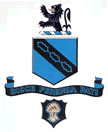 The Arms of Longdendale are based on the family arms of the Hollingworths of Hollingworth Old Hall, the three holly leaves are a reference to their name. The sheaf represents the Earldom of Chester and the demi-lion refers to the Cheshire arms.
The Arms of Longdendale are based on the family arms of the Hollingworths of Hollingworth Old Hall, the three holly leaves are a reference to their name. The sheaf represents the Earldom of Chester and the demi-lion refers to the Cheshire arms.
The motto is that of the Hollingworth family 'Learn to endure what must be borne'.
History of Mottram-in-Longdendale
Early History
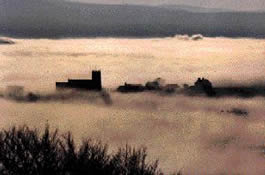 The parish of Mottram contained eight townships: Mottram, Godley, Hattersley, Newton, Hollingworth, Tintwistle, Matley and Staley. Various derivations are attributed to the name, but it is generally supposed that it denotes a meeting place. At the beginning of the 19th century the population was less than 1,000, by the middle of the century it had tripled, but began to decline in the 1860s.
The parish of Mottram contained eight townships: Mottram, Godley, Hattersley, Newton, Hollingworth, Tintwistle, Matley and Staley. Various derivations are attributed to the name, but it is generally supposed that it denotes a meeting place. At the beginning of the 19th century the population was less than 1,000, by the middle of the century it had tripled, but began to decline in the 1860s.
In the Middle Ages, Mottram was important in the district. The lesser manor of Stavely was held under the greater one of Mottram and, at about the 16th century, the former was in the parish of Mottram. It was the centre of religion for the surrounding villages, while, in the later 18th century, the manorial court-house was situated in Mottram. In the infancy of the cotton trade, Mottram had sizeable cotton-spinning concerns in the Wedneshough and Treacle Street area. In the early 19th century, Mottram was the district centre for shoe-making and tailoring, as well as for cultural activities such as botanical studies, music, change-ringing and folk-pastimes, including rush-cart events and morris dancing. It also gained importance from being on the coach route from Manchester to Sheffield.
Communications
In addition to the Manchester to Sheffield coach route there was, about 1830, a flying coach between Manchester, Stalybridge and Mottram called the Umpire. The Pack Horse Inn was a stopping place for pack horse trains on the saltway from Cheshire through to Yorkshire. In the 1860s the coaches were replaced by train. In the early 19th century, another aspect of the communications system was the Peak Canal which brought lime as far as the Etherow Valley to help keep the land fertile. Before the Peak Canal, lime had to be brought to the district by pack horse from Chapel-en-le-Frith.
With the advent of steam power and the discovery of (inferior quality) coal, some of the 18th century industries included cotton spinning, winding and doubling, cotton bleaching and quarrying. Railways and the growth in manufacturing developed surrounding places until they no longer relied on Mottram while Mottram itself, unsuited to modern manufactures, declined. Industrialisation led to social conflict; in 1812 hunger in the area fired Luddite riots against labour-reducing machines and in 1842 leading local Chartists participated in meetings held on Wedneshough Green where Luddites had once secretly drilled. There they planned the closure of Stalybridge factories in the Plug Riots.
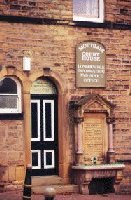 Education and Religion
Education and Religion
Since the ancient grammar school was defunct, a school was opened in the Wedneshough neighbourhood of Mottram by public subscription in 1794. Later another school was built in the same neighbourhood and, in 1857, the grammar school was re-established. Joshua Reddish, a Mottram grocer, promoted a substantially built stone school at the church steps and at Broadbottom a hand-spinner, John Andrew, promoted local education and the building of a school.
The religious groups also provided education, among them the New Connexion Methodists, who built a Sunday School in the 1860s. In the 1840s this New Connexion community seceded from the New Connexion Conference and set up independently as Christian Brethen (later Unitarians). The most important religious edifice in Mottram is the parish church. There was a church on the site in the 13th century. Externally, the present church is 15th century. In 1854 the church was partially restored - the ancient stone font being restored to its original position, having been long used as a rain-water butt and John Chapman, who became the impropriator about 1860, restored the Stayley Chapel. But Ralph Robinson, wrote in 1863, that 'Mottram Church, like most old churches, has suffered from 'the spoilers hand', and cupidity, ignorance and fanaticism, have reft of its ancient glory".
Characters
Two outstanding local characters of the past were Lawrence Earnshaw (1707-1767) and John Chapman (1810-1877). Earnshaw was a remarkably prolific inventor and machine maker with considerable skill in many fields - among them gilding, engraving, painting, smithying and joinery. His masterpiece was an astronomical clock, which took seven years to make. His most significant invention, of 1753, was a machine to spin and reel cotton in a single operation but, after demonstrating its capabilities to friends, he destroyed it, fearing that it might make textile workers redundant. He died in poverty, but a monument to him in Mottram cemetery was unveiled in 1868. John Chapman, MP for Grimsby, High Sheriff of Cheshire, JP and Chairman of the Manchester, Sheffield and Lincolnshire Railway, lived in Broadbottom and promoted Mottram Library and reading room and local musicianship. During the cotton famine of the 1860s he helped alleviate the suffering of the poor by improving his estates, thereby giving considerable employment to Mottram people, and by giving food and clothing to hundreds of locals each week. A religious man, trained for the Anglican ministry, he helped restore Mottram Church, financially supported a clergyman and in Parliament defended religious education in schools.
The Twentieth Century
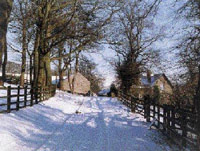 In 1936 the Urban District of Longdendale was formed consisting of Broadbottom, Hollingworth, Mottram and parts of Hattersley and Matley. The artist Laurence Stephen Lowry (1887-1976), came to live in Mottram in 1948. His house 'The Elms' is on Stalybridge Road and he lived there until his death. He was born in Stretford and trained at the Manchester Municipal College of Art and Salford School of Art. He has become particularly well-known for his depiction of the industrial North West with its characteristic mills, chimneys and terraces.
In 1936 the Urban District of Longdendale was formed consisting of Broadbottom, Hollingworth, Mottram and parts of Hattersley and Matley. The artist Laurence Stephen Lowry (1887-1976), came to live in Mottram in 1948. His house 'The Elms' is on Stalybridge Road and he lived there until his death. He was born in Stretford and trained at the Manchester Municipal College of Art and Salford School of Art. He has become particularly well-known for his depiction of the industrial North West with its characteristic mills, chimneys and terraces.
In recent years Mottram and the surrounding districts have become a popular residential area. The mills are now converted into small industrial units and the textile industry is no longer the main employer.
Facts About Longdendale
A comprehensive selection of historical photographs can be found at www.tameside.gov.uk/history
- Laurence Stephen Lowry (1887- 1976) was an artist of national repute, well known for his urban industrial landscapes and highly personal style, L S Lowry attended Walter Sickert's Manchester art classes in 1925 along with Harry Rutherford (qv). Although the majority of his subjects are Manchester and Salford based, he did draw and paint a number of Tameside scenes, while in his later life he developed a liking for sea and landscape pictures to the virtual exclusion for industrial subjects. Lowry lived for most of his life in Pendlebury, working as a clerk for the Pall Mall Property Company in Manchester, but retired to The Elms, on Stalybridge Road in Mottram. It was during the final years of his life here that he achieved national recognition with membership of the Royal Academy, the freedom of the City of Salford and doctorates from three universities. Nine months after his death a major retrospective of his work was held at the Royal Academy.
- The earliest surviving building specifically built for the textile industry in Tameside is Dry Mill, Mottram which is now converted into cottages. This building was erected in the1790's by John Wagstaffe, probably for the hand- or horse-powered spinning of cotton. There were many such structures in the Longdendale area during the initial cotton boom of the 1780's and1790's, but this is the only known surviving example.
- Lawrence Earnshaw (c 1707-67) was born at Mottram Moor into a poor weaving family. He had little formal education but from an early age, displayed a keen interest in all types of machinery especially clocks. He seems to have educated himself to a remarkable degree and to have mastered all manner of trades. Earnshaw made many clocks, usually the long case variety but one of his outstanding achievements was an elaborate astronomical clock. In Mottram Court House there is a long case clock which bears Earnshaw's name. Earnshaw died at Mottram on May 12th, 1767 and was buried in St. Michael and All Angels Churchyard in an unmarked grave.
- St. Michael and All Angels Church, Mottram dedicated to St. Michael commands a magnificent view. It has been called the Cathedral of East Cheshire. It was first mentioned in 1291 when a tax was levied on ecclesiastical revenues by Edward I. Much of the exterior is fifteen century. The Church tower was erected with money provided by Sir Edmund Shaa. He is reputed to have been born in Mottram and is said to have walked to London where he became a goldsmith and was three times Lord Mayor. The Church has a chapel in which the stone effigies of the Crusader Knight Sir Ralphand Lady de Staveleigh lie. Apart from the chancel piers and arch most of the interior was renovated in 1854-55. The best features of the interior are the tower arch at the west end of the nave and the four centred pointed chancel arch. On either side of the north doorway are bread racks, dated 1619 and 1737. Bread was distributed to the poor on Sunday mornings after the service. To the left of the cemetery is a long stretch of land, the equivalent of about five graves which is said to have been left for the free burial of the first five men of Mottram to die of overwork.
- Hundreds of Mottram people of all ages put their green fingers to good use. For they won the town runners up prize for best large village in the 1999 Britain in Bloom competition.
- William Brereton (1490-1536) was a courtier under Henry VIII and became the most powerful individual in Cheshire and North Wales under that king by the acquisition of extensive estates and crown offices in the period 1522-34. Among these grants was the stewardship of Longdendale which he received in 1525. His enormous wealth and power led to his downfall and execution. A supporter of Queen Anne Boleyn's court faction, Brereton along with others was accused of adultery with the queen. He was executed on Tower Hill in London on 17th May 1536 and his lands confiscated by the state.
- Tollemache Family - When Sir Thomas Wilbraham of the Wilbraham family of Woodhey died in 1692 his Cheshire estates, including the manors of Mottram and Tintwistle and the lordship of Longdendale, were inherited by his son-in-law Lyonel Tollemache, the earl of Dysart in Scotland. The Tollemache family were absentee landlords throughout their period of ownership and employed a steward to run their extensive Longdendale estates. There were at least 25 tenants in Mottram in 1727, and 100 tenants in 1799. In 1873 the family held 25,830 acres in Cheshire, which returned an annual gross rental of £27,602 11s. Although the Tollemache family sold parts of their north-east Cheshire estates in 1841 and 1852, most lands were kept until the Mottram estate was sold in 1919. The title of the lord of Longdendale was retained by the family until it too was sold, in 1980, to Tameside Metropolitan Borough Council.
- John Frederick Bateman was born in 1810 at Lower Wyke, near Halifax. His blue plaque is located at the Mottram Tunnel, Longdendale
- The blue plaque located on Mottram Court House, Jackson Street, Mottram was unveiled on 22nd August 2001 as a tribute to Francis Lovell, Lord of Longdendale.
- The Green Plaque at The Broadoak Hotel in Ashton-under-Lyne, marks the site where the first 'Gardeners Question Time' was broadcast. On that first panel was Bill Sowerbutts.
Places of Interest in Longdendale
Visitors to Mottram-in-Longdendale today see an attractive village with a peaceful air. The village has a rich and colourful history
Court House, Mottram-in-Longdendale
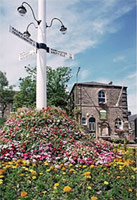 Law and order was represented by the Court House where the Court Leet met. Early methodists also used the building for their Sunday School from 1789 to 1791. The stocks outside were brought from the village of Hattersley where they were dug up during work on the Manchester overspill housing estate. The original Crown or Coronation Pole was erected in 1760 to commemorate the coronation of George III.
Law and order was represented by the Court House where the Court Leet met. Early methodists also used the building for their Sunday School from 1789 to 1791. The stocks outside were brought from the village of Hattersley where they were dug up during work on the Manchester overspill housing estate. The original Crown or Coronation Pole was erected in 1760 to commemorate the coronation of George III.The drinking fountain against the Court House wall commemorates the introduction of a piped water supply to the village in 1888. It shows the former water cart at Spout Green - the hamlet which stood on Old Road. It got its name from a spring which fed a spout, still to be seen, from which fresh water was carried in a cart to Mottram for sale at ½d for three gallons.
St Michael's and All Angels Church
 A beacon of Christianity for 700 years, Mottram church is now a beacon in the literal sense, having been floodlit as part of Tameside Council's activities to mark the millennium.
A beacon of Christianity for 700 years, Mottram church is now a beacon in the literal sense, having been floodlit as part of Tameside Council's activities to mark the millennium.The floodlighting was financed by the council at a cost of £15,000, and the work was completed in conjunction with the Chester Diocese and Graham Holland Architects with assistance from James Bell, Professor Emeritus at the Manchester University School of Architecture.
The switch-on ceremony in July (1999) was performed by Cllr Roy Oldham, the then Executive Leader of Tameside Council and the Rev Tony Rees, Vicar of Mottram.

